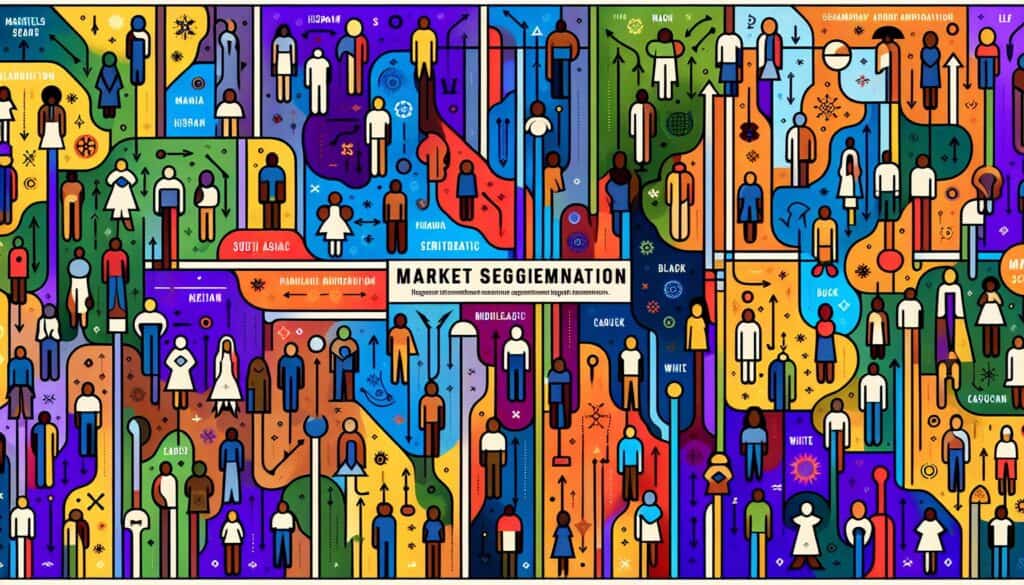Unterteilung eines breiten Zielmarktes in kleinere, genauer definierte Untergruppen von Verbrauchern, die gemeinsame Bedürfnisse, Interessen und Prioritäten haben.
- Methodologien: Ergonomie
Marktsegmentierung

Marktsegmentierung
- Kundenerfahrung, Customer Journey Mapping, Marktforschung, Marketing, Marketingstrategie, Produktdifferenzierung, Produktpositionierung, Zielpublikum, Wert-Angebot
Zielsetzung:
Wie es verwendet wird:
- Identifizierung von Schlüsselmerkmalen (z. B. demografische, geografische, psychografische und verhaltensbezogene Merkmale), um potenzielle Kunden zu gruppieren, so dass Unternehmen Marketingstrategien und Produktangebote auf bestimmte Segmente zuschneiden können.
Vorteile
- Ermöglicht gezielteres und effektiveres Marketing; hilft bei der Ermittlung neuer Marktchancen; kann zu höherer Kundenzufriedenheit und -treue führen.
Nachteile
- Die Erforschung und Umsetzung kann kostspielig und zeitaufwändig sein; die Segmente müssen zugänglich und groß genug sein, um rentabel zu sein; die Verbraucherpräferenzen können sich im Laufe der Zeit ändern.
Kategorien:
- Kunden & Marketing
Am besten geeignet für:
- Ein breiter Markt wird in verschiedene Untergruppen aufgeteilt, um Marketingmaßnahmen und Produktangebote effektiver zu gestalten.
Market segmentation is often utilized across various industries such as consumer goods, technology, healthcare, and automotive, playing a significant role in the design and development phases of products and services. In sectors like consumer electronics, companies segment the market based on age and technological proficiency, enabling the creation of user-friendly interfaces for older adults or high-tech features for younger consumers who are more adept with advanced technology. The initiative for segmenting markets typically comes from marketing teams, product managers, and data analysts who work collaboratively to analyze demographic data, online behaviors, and purchasing patterns. For instance, real estate firms often segment their market geographically to focus on urban versus suburban buyers, tailoring property features, and marketing messages to fit localized preferences. Psychographic segmentation can inform branding strategies by identifying the values and lifestyles of different consumer groups, such as eco-conscious buyers who prioritize sustainable products. Behavioral segmentation delves into consumer habits, allowing companies to create loyalty programs that cater specifically to frequent buyers or those who engage with the brand on social media. The process can result in discovering untapped markets, as organizations gain familiarity with niche audiences, which can lead to enhanced customer satisfaction through offerings that resonate well with each group’s unique needs and preferences. This systematic approach not only refines marketing communications but also enhances the overall product experience, fostering long-term relationships with customers driven by personalized engagement.
Die wichtigsten Schritte dieser Methodik
- Define the overall market and its size.
- Identify relevant segmentation variables: demographic, geographic, psychographic, and behavioral.
- Develop profiles for each segment based on identified characteristics.
- Evaluate the attractiveness and feasibility of each segment.
- Select target segments for marketing efforts and product development.
- Design customized marketing strategies for each selected segment.
- Implement the strategies and monitor performance across segments.
- Adjust strategies as needed based on feedback and market changes.
Profi-Tipps
- Utilize advanced analytics tools to identify and visualize patterns within customer data, enabling more precise segmentation.
- Conduct ethnographic research to uncover deep-rooted consumer behaviors and preferences that quantitative data might overlook.
- Implement iterative testing of segment-specific marketing strategies to adapt and optimize offerings based on real-time customer feedback.
Verschiedene Methoden lesen und vergleichen, Wir empfehlen die
> Umfassendes Methoden-Repository <
zusammen mit den über 400 anderen Methoden.
Ihre Kommentare zu dieser Methodik oder zusätzliche Informationen sind willkommen auf der Kommentarbereich unten ↓ , sowie alle ingenieursbezogenen Ideen oder Links.
Historischer Kontext
1960
1980
1983
1990
1995
2000
2010
1950
1980
1980
1986
1994
1995
2000
(wenn das Datum nicht bekannt oder nicht relevant ist, z. B. "Strömungsmechanik", wird eine gerundete Schätzung des bemerkenswerten Erscheinens angegeben)














Verwandte Artikel
Fragebögen zu muskuloskelettalen Beschwerden
Multivariate Tests (MVT)
Mehrfache Regressionsanalyse
Motion-Capture-Systeme
MoSCoW-Methode
Moods Median-Test